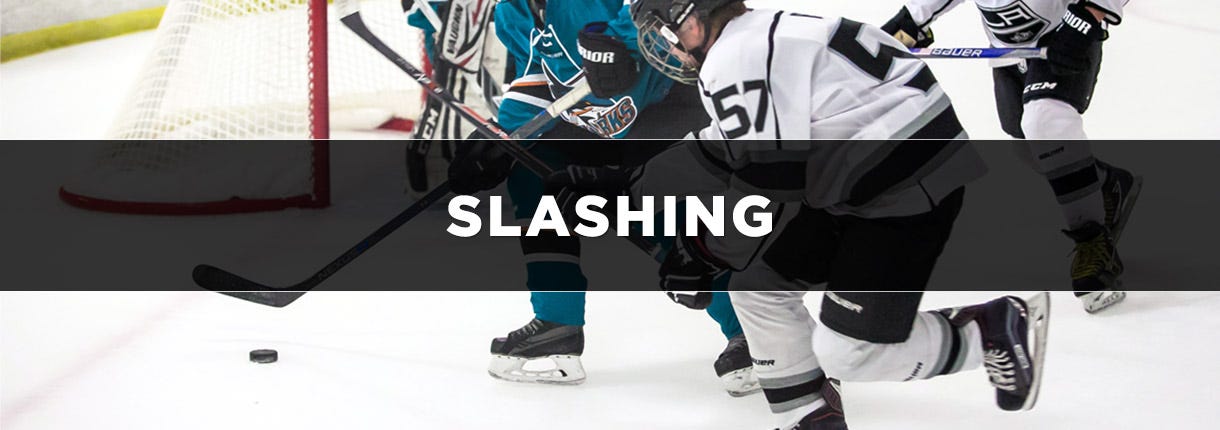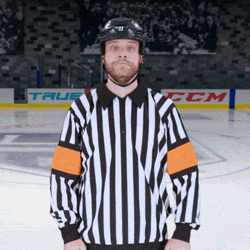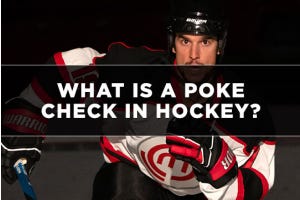Slashing in Hockey: A Guide to the NHL’s Slashing Penalty

Slashing in hockey is a penalty that is called when a player swings his stick at an opposing player, whether contact is made, or not. The act of a “forceful chop” motion to an opponent’s stick or gloves will typically result in a Minor Penalty.
However, there are certain situations where slashing is more severe and can call for a Major Penalty or Game Misconduct Penalty. It is to the referee’s discretion to determine the severity of the act.
Check out our website for a wide variety of hockey gloves and hockey sticks!
- Video Example of Slashing
- Referee Signal for Slashing
- What are the Penalties for Slashing?
- The Official NHL Slashing Rule Text (Rule 61)
- NHL Slashing Rule History
Video Example of Slashing
In the video above, Gudas (Flyers player, white jersey) can be seen getting tangled up with Perrault (Jets player, blue jersey) and Perrault ends up falling to the ice. While on the ice, Gudas brings his stick down forcefully with both hands and makes contact with Perrault’s neck.
This forceful chopping motion delivered to a defenseless player resulted in a five-minute Major Penalty for Gudas.
Referee Signal for Slashing

The referee will hold out one arm. Using the other arm, they will make a “chopping” motion and contact the extended forearm.
What are the Penalties for Slashing?
Almost all Slashing situations will result in either a two-minute Minor Penalty or a five-minute Major Penalty. As to which one is called, depends on the severity of the infraction and is at the referee’s discretion.
If a player slashes an opposing player, intentionally or unintentionally, and injures said player, a Major Penalty and Game Misconduct will be assessed to the guilty player. This results in the guilty player being removed for the duration of the game.
A player that slashes his stick at the opposing goalie will be assessed a Minor Penalty.
The Official NHL Slashing Rule Text (Rule 61)
"Slashing is the act of a player swinging his stick at an opponent, whether contact is made or not. Non-aggressive stick contact to the pant or front of the shin pads, should not be penalized as slashing. Any forceful or powerful chop with the stick on an opponent’s body, the opponent’s stick, or on or near the opponent’s hands that, in the judgment of the Referee, is not an attempt to play the puck, shall be penalized as slashing."
NHL Slashing Rule History
In late 2016, going into the 2017-2018, the NHL announced that it would be cracking down on slashing infractions moving forward. So what did this mean exactly? This meant that effective immediately, the NHL officials would be paying closer attention to infractions that meet the exact definition of what a hockey slash is.
In years prior, some referees would allow players to tap the opposing puck carriers gloves (in an attempt to make him mishandle it) and not call a slashing penalty, while other referees would enforce the rule and call a slashing penalty. This allowed for a lot of confusion and inconsistencies within the games. Not only did this cause confusion for the players, but the fans watching as well.
As a result of the leniency, hand injuries became more frequent. So, starting with the 2017 season, NHL officials began closely watching for stick infractions that followed the exact criteria of a Slashing penalty. As a result of the stricter enforcement, the game has seen fewer injuries directly related to the change, as well as a more consistent and balanced game for players and fans.









Login and Registration Form
or
Create an account